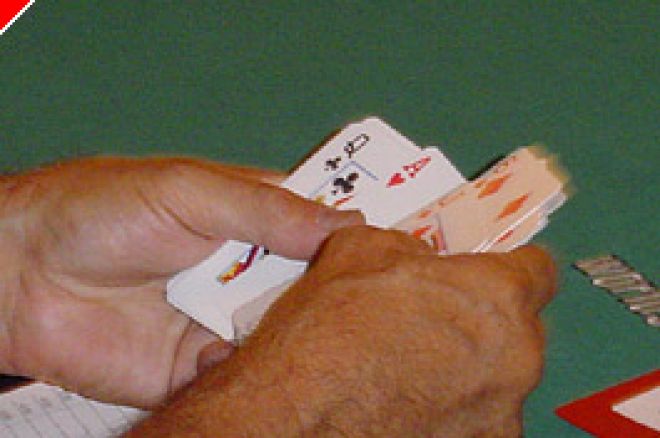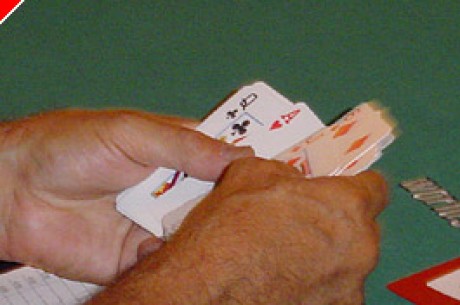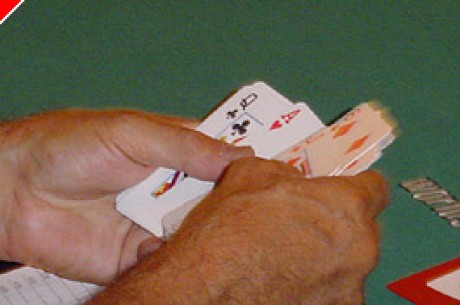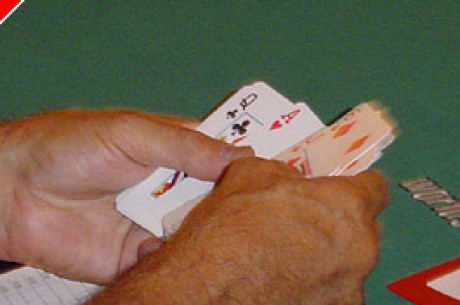Stud Poker Strategy - Playing in Big Games

The conventional poker wisdom is to never play in a game where you can't afford the stakes. There are conventional guidelines for figuring this out. The poker pundits peg your playing bankroll at 300 or so times the big bet. If you want to play $20/40 you're suppose to have a bankroll of no less than $12,000. If you want to play $75/150 you should have no less than $45,000. That's what the pros tell us. Who are we to disagree?
But does everyone who plays poker really need that much money just to play? And what if you don't have it? Are there any steps you can take to compensate for being caught short?
Let me start by telling you that I'm a very conservative player. I'm not much of a gambler. I like to play well within my bankroll - and have a natural playing style that is quite tight - if aggressive when I think I have an edge. Given a choice of playing big and playing tiny I'd normally choose tiny. I'd rather be safe than be challenged. I don't enjoy the sensation of having the money riding on the turn of a card.
That being said, I think that it's a mistake to limit yourself to just those games where you are able to play with the full bankroll described above. I think that's much too conservative.
Don't get me wrong. I'm not recommending that you make a steady diet of that kind of action without the by-the-book proper stake. I'm just saying that there's a difference between playing at a level full-time as a professional who only derives his income from poker and taking a shot at a higher game when you have a renewable supply of poker money or when you only plan on playing for a short time.
Technically, all you need to play in a game is the minimum buy in. For $10/20 that's $100. For $20/40 that's $400. For $75/150 that's $1,500. You have the dough and you want to take your shot? Who am I to stop you? Go for it. You might win a few hands and be set for the rest of your life, never to look back.
There are some reasons to approach a game when you are short of the full bankroll you might ideally want to have. It's not all about gambling it up. Here are some of those reasons.
Suppose your $5/10 game is dead. Everyone is as tight as an impoverished priest. On the other hand, the nearby $10/20 game is rocking and rolling. It's filled with fish and timid Tims. You've got $200. Go ahead and take your shot.
You can help minimize your risk without eliminating your ability to play. Play a bit less speculatively than you might normally play in a lower stakes game or with a fuller bankroll. Don't go for those flush or straight draws. Do less semi-bluffing. Play a generally tighter game - at least until you've won some hands and have built up your bankroll. But for starters, you're going to batten down the hatches and play a minimalist tight/aggressive game.
You also don't have to stay very long. If you take a couple of bad hits, go back down to $5/10. If you win a few big pots and start to feel nervous about losing it back, go back down. In short, hit and run. There's no shame in that.
Of course there are risks of playing higher. I had an experience that may serve as a cautionary tale to those of you thinking of stepping it up a notch or two.
It was Saturday night on a holiday weekend at Foxwoods - one of the two busiest poker rooms in the world. I put my name on the $20/40 stud list but had a loooooong way to go before I was called. The $5/10 and $10/20 games were worse -as were the $5/5, $2/5 no limit and $5/10 limit hold 'em games that I also play.
I saw that the only game with no list was $75/150 stud. I had never played stud that high. In fact, the highest I had ever played was $30/60 at Caesar's, the riverboat casino in New Albany, Indiana.
So, eager to play and being virtually shut out of all the other games, I looked at the big game in the corner. The players didn't seem super human. I had played against a few of them at $20/40. I had a large bankroll after having written a few articles. What the Hell, I thought. I'll take my shot.
I sat down. The game was full. I played a full 25 minutes - not counting the time I had to leave the table to buy $5,000 worth of chips from the cashier. I was dealt 15 hands.
I can honestly tell you that I was dealt absolute drek. I got only hands like (7s9c)4d, (Jh8s)Qc, and (4s9h)Ts - nothing better. I folded every single time.
But that wasn't the interesting part. The learning experience was this. The game was so much higher than I was used to playing, and so much more aggressive because of the huge initial pot compared to the initial bet, that I was actually hoping to get a bad hand. I wanted garbage so I could correctly fold rather than face bets and raises that would have cost me nearly $800 a hand if I stayed until the River.
That to me is the biggest problem of playing a higher stakes game than you're used to playing. If it's $20/40 or higher then you're facing a level of aggression that you're not going to be used to - because of the ante/bring-in size. That aggression is very intimidating if you're not used to it. Your plan to play a tight/aggressive game yourself can easily be torpedoed and replaced by a tight/terrified style that will surely prevent you from playing well.
As it was I was mercifully called to the $20/40 game, my tail between my legs and my wallet $250 lighter (literally the cost of just sitting and folding every single hand).
There is one good product of this otherwise ridiculous experience. The next time I step up to $75/150 I won't be as intimidated. I will have had at least one experience, however bad, in that game, making the second experience all the easier.
Ed Note: Play at limits so high, the air is thin at Everest Poker








